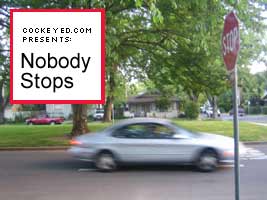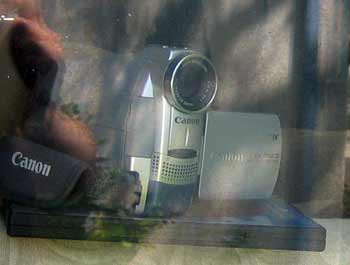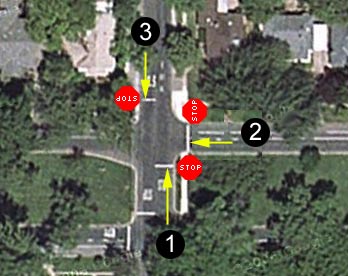


|
|

|
 The number one rule of automobile driving is Avoid Collisions. A ton
of other rules and laws describe how to best achieve this goal.
The number one rule of automobile driving is Avoid Collisions. A ton
of other rules and laws describe how to best achieve this goal.
One of these laws is in California Vehicle Code Section 22450(a). The driver approaching a stop sign at the entrance to...an intersection...shall stop at the limit line...on the near side of the intersection. If you are like me, you may have noticed that this law is widely interpreted as: You don't actually have to stop, but the driver must slow considerably and sufficiently to avoid a collision or citation. I wondered what percentage of drivers actually stopped fully, and what portion just rolled slowly by. When our family moved into a new house near a three-way stop, I had my chance to conduct a genuine scientific stop-sign survey. |

The first step was to set up a video camera with a view of the intersection. T Street is divided by a wide, grassy island. There are trees, but the deep lawns allow an excellent view of cross traffic. I use a Canon ZR65 digital camcorder. I've been buying Canon cameras for a while now. They rule. With the camera in place, I rolled tape, capturing a full hour of intersecting traffic. |

The intersection is a three-way stop. The horizontal street shown in this Google aerial photograph is a one-way street traveling west (in the direction of the #2 yellow arrow). Cars entering the intersection from the east have a stop sign. The intersecting cross traffic can approach the intersection from the north or the south. My hidden camera captured all of the action in this intersection. A total of 276 cars passed through the intersection in this hour. They all had stop signs. They did not all stop. |

I should mention, if you are tempted to repeat this experiment, that I threw out an entire hour of video after realizing the camera had auto-focused on the insect screen. |
please continue reading page two of Nobody Stops
contact Rob | science club | pranks | How much is inside? | Home | Incredible Stuff I Made | Torn-up Credit Card Application
May 21st, 2006